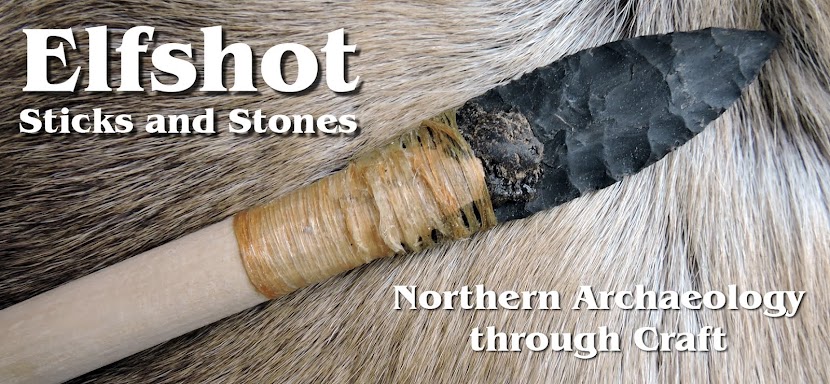This morning, my friend Patty is popping over to borrow some of my antler tools. She's the Ph.D. student at Memorial University who is studying Palaeoeskimo organic artifacts. I did some experimental work with her early in 2008. She'd like to examine the usewear on my knapping tools under a microscope to compare to some of the artifacts in her collection.
Since I have antler on my mind this morning, here's another look at some of the caribou antler pieces that I'm working on right now.
Here's how the adze socket is shaping up. The last time I showed this piece it was soaking in vinegar to soften it, so that I could wedge the socket open wider. The vinegar really does the trick. After 24 hours or so the prous interior of the antler turns to soft sponge and the dense outside turns to hard rubber. I think that prolonged soaking would probably irreversibly harm the antler, but its been slowly hardening every since, so I'm not worried it will permanently feel like a wet rubber tire. I pounded a progressively larger series of wedges into the socket and its very close to the correct width.
I've been having some good luck with the rock dust and carpenter glue surface treatment on the antler to match the dusty, cracked look of bleached antler. I've been testing it along the way on the reproduction of an antler tine section. A piece like this is hard because there is so little modification to the antler that its very difficult to find an antler that just happened to grow in an identical pattern. I found as good a match as I could and have been slowly modifying it. I've cut, ground, bent, pressed, rebuilt, and antiqued this little reproduction so much over the summer that I'm amazed it still looks like antler. The weathered surface helps cover all the abuse I've heaped on it, but even before the antiquing I'm surprised how resilient the antler is to being torn down and built back up again.
When I have the final dimensions, I need to drill the series of holes across the bottom. I think the original artifact is a discarded waste piece - it was the piece that was sawed off and thrown away. The interesting thing is that it wasn't cut with a saw, a series of holes were drilled through the antler and it was cracked off. With a bow drill, an operation like that would take about the same amount of time as sawing through the antler. A lot of the artifacts that I'm reproducing this summer have holes drilled in them.
Many of the holes were drilled so that two different pieces could be lashed or rivetted together. This little brace piece has 3 complete holes of at least 2 different diameters (and therefore 2 different drillbits) and it was broken through a fourth hole. In this photo the reproduction is almost finished, except for the antiquing, so it gives a good sense of how different fresh antler looks compared to old bleach antler.
Finally, this barbed antler point still has the iron rivets in place. There is a longer, skinnier brace piece still in place on the other side. (a complete view of this barbed point is here). I've included this picture to show the texture match between the artifact, on the left, and the reproduction, on the right. This particular artifact has a greenish tinge, so I'll use serpentine dust when it comes time to antique the reproduction. There is also some lichen growing on it, which I'll add to the reproductions after I'm happy with the rock dust antiquing.
Photo Credits: Tim Rast
Photo Captions:
Top, The antler tools in my flintknapping kit
Second, Side by side comparison of the antler socket, original is on the bottom
Third, wedging open the socket
Fourth, Antler tine artifact (right) and reproduction in progress (left)
Fifth, Drilled antler artifact (left) and reproduction in progress (right)
Sixth, Barbed point artifact next to the antiqued surface of a different reproduction







No comments:
Post a Comment